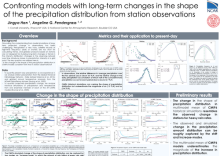Confronting models with long-term changes in the shape of the precipitation distribution from station observations
Jingya
Han
Department of Earth and Atmospheric Sciences, Cornell University
Poster
The distribution of precipitation, including its extremes, is changing in response to global warming with devastating impacts on humans, infrastructure, and ecosystems. In order to prepare for, and adapt to, these extreme weather events, quantitative descriptions of long-term changes in the shape of the intensity distribution of daily precipitation are needed.
Currently, much of our understanding of long-term changes in the intensity distribution comes from model simulations. Previous work from this group has shown that the response of the precipitation amount distribution to primarily greenhouse-gas driven warming can be captured by two “modes” of change: an “increase mode” in which the amount of rain falling at every rain rate increases by about 1% per K of warming, and a “shift mode” in which the same amount of rain falls at a 3.5 % per K heavier rain rate. Together, these modes of change of the precipitation distribution capture the mean also extreme changes that are widely documented in climate model simulations. At individual grid points in space, the modes of change also apply with some geographic modulation of magnitude.
But grounding the understanding from model simulations of long-term projected change in observations has been challenging. Precipitation is very noisy, satellite records of high-time frequency (daily or shorter) are too short for calculating trends, and gridded products based on stations are not designed for studying long-term changes or trends in the intensity distribution; changes in the observing network over time introduce biases to precipitation intensity at a grid point. In this study, this gap will be addressed by using station-based observations which extend back for over 60 years.
This knowledge gap will be addressed in this study, using station-based observations from the Global Historical Climatology Network Daily (GHCNd) dataset extending back at least 60 years. Results will document the modes of change of the precipitation distribution in station observations, and compare them against co-located grid points from climate model simulations.
Currently, much of our understanding of long-term changes in the intensity distribution comes from model simulations. Previous work from this group has shown that the response of the precipitation amount distribution to primarily greenhouse-gas driven warming can be captured by two “modes” of change: an “increase mode” in which the amount of rain falling at every rain rate increases by about 1% per K of warming, and a “shift mode” in which the same amount of rain falls at a 3.5 % per K heavier rain rate. Together, these modes of change of the precipitation distribution capture the mean also extreme changes that are widely documented in climate model simulations. At individual grid points in space, the modes of change also apply with some geographic modulation of magnitude.
But grounding the understanding from model simulations of long-term projected change in observations has been challenging. Precipitation is very noisy, satellite records of high-time frequency (daily or shorter) are too short for calculating trends, and gridded products based on stations are not designed for studying long-term changes or trends in the intensity distribution; changes in the observing network over time introduce biases to precipitation intensity at a grid point. In this study, this gap will be addressed by using station-based observations which extend back for over 60 years.
This knowledge gap will be addressed in this study, using station-based observations from the Global Historical Climatology Network Daily (GHCNd) dataset extending back at least 60 years. Results will document the modes of change of the precipitation distribution in station observations, and compare them against co-located grid points from climate model simulations.

Poster file
han-jingya-confronting-poster.pdf
(2.37 MB)
